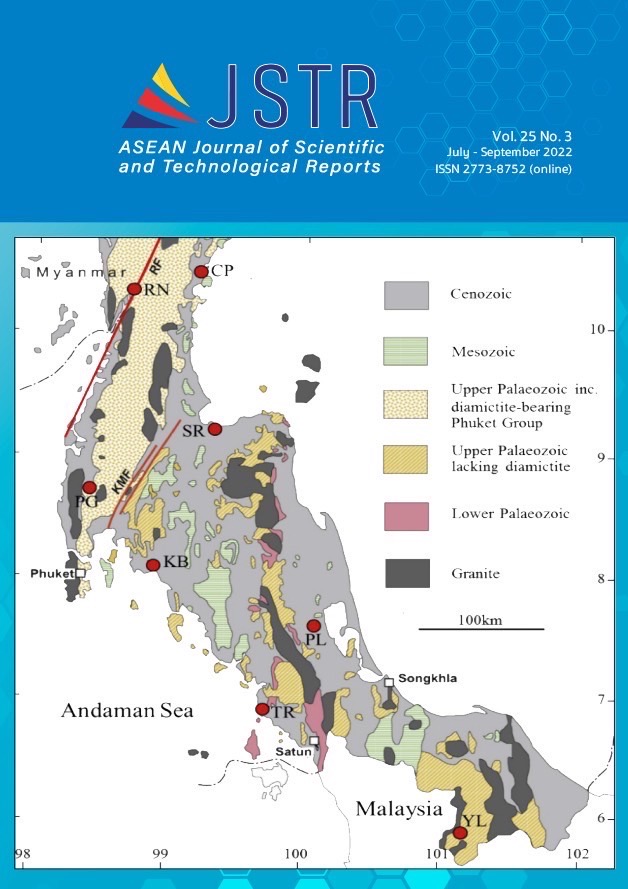Annual Dose Analysis of Pottery from Thoud-Ta Thoud-Yai Archaeological Site in the Songkhla Province of Southern Thailand
Main Article Content
Abstract
Thoud-Ta Thoud-Yai is Thailand's oldest archaeological site. Identifying the age of artifacts helps link past and present in storytelling. Absolute dating techniques are used to estimate a sample's geological age. Calculating the annual dose is the essential step. The annual dose depends on samples' concentrations of natural radionuclides and the sediment surrounding them. This research performed the annual radiation dose analysis in pottery by quantifying the concentrations of natural radionuclides using Neutron Activation Analysis (NAA). According to the volume analysis, internal dose, external dose, and cosmic rays contribute 0.180 ± 0.027, 0.959 ± 0.110, and 0.177 ± 0.009 mGy/year, respectively. The annual dose was found to be 1.139 ± 0.113 mGy/year. Annual dose measurements are necessary for determining the age of pottery samples. Since the age is determined by dividing the equivalent dose by the annual dose, this result connects the past and present at the Thoud-Ta Thoud-Yai archaeological site.
Article Details

This work is licensed under a Creative Commons Attribution-NonCommercial-NoDerivatives 4.0 International License.
References
Hubert, L. Calibration standard for use in gamma spectrometry and luminescence dating. Methods and Applications of Absolute Chronology. 2001, 20, 31-38.
Vichaidid, T.; Soodprasert, T.; Sastri, N. Determination of U, Th and K in Sediments and Fossil Collected from Mae Moh Mine Using Gamma-Ray Spectrometry and Neutron Activation Analysis (NAA). Kasetsart Journal. 2008, 42, 333-339.
Shimada, A.; Toyoda, Y.; Takagi, H.; Arita, K. ESR dating of pseudotachylite. American Geophysical Union, Fall Meeting. 2002.
Hossain, S. M.; De Cortea, F.; hauteb, P. A comparison of methods for the annual radiation dose determination in the luminescence dating of loess sediment. Nuclear Instruments and Methods in Physics. 2002, 490, 598-613.
Adamiec, G.; Aitken, M. Dose-rate conversion factors: update. Ancient TL. 1998, 16(2), 37-50.
Ikeya, M. New Applications of Electron Spin Resonance Dating, Dosimetry and Microscopy. Singapore: World Scientific. 1993.
Robert, R.; Peter, Bode.; Elisabete, A.; De Nadai Fernandes. 2011. Neutron activation analysis: A primary method of measurement. Spectrochimica Acta Part B. 2011. 66, 193-241.
The 13th Songkhla Fine Arts Department. Archaeological survey and excavation from Songkhla and Satun province Unpublished report. 2010. 25-27, 145-154.
El-Ghawi, U. M.; Bejey, M. M.; Al-Fakhri, S. M. A.; Al-Sadeq, A.; Doubali, K. K. Analysis of Libyan arable soils by means of thermal and epithermal NAA. Arabian Journal of Science and Engineering. 2005, 30, 147-153.
Rossini, I.; Tripier, T.; Ch. Abbé, J.; Guevara, B.; Tenorio, R. Neutron activation analysis of U, Th, K and Rb in archaeological samples from Guayabo (Costa Rica) prior to thermoluminescence dating. Journal of Radioanalytical and Nuclear Chemistry. 1991, 154, 173-183.
Ferreira Jr, F.A.; Maidana, N.L.; Vanin, V.R.; Koskinas, M.F.; Lopez-Pino, N. 41K(n, γ)42K thermal and resonance integral cross section measurements. Radiochimica Acta. 2012, 100, 871–877. https://doi.org/10.1524/ract.2012.1985.
Johannes, H. A workflow for neutron activation analysis of archaeological ceramicsat the Atominstitut in Vienna, Austria. Radioanalytical and Nuclear Chemistry. 2018, 316, 753–759.
Zimmerman, D.W. Relative thermoluminescence effects of alpha- and beta- irradiation. Radiation Effects. 1972, 14, 81-92.
Vichaidid, T.; Youngchuay, U.; Limsuwana, P. Dating of aragonite fossil shell by ESR for paramagnetic species assignment of Mae Moh basin. Nuclear Instruments and Methods in Physics Research Section B: Beam Interactions with Materials and Atoms. 2007, 262(2), 323-328.
Aitken, M. J. An Introduction to Optical Dating. Oxford University Press, Oxford. 1998.
Ikeya, M. Dating a stalactite by electron paramagnetic resonance. Nature. 1975, 255, 48-50.
Guerin, G.; Mercier, N.; Adamiec, G.; Dose-rate conversion factors: update. Ancient TL. 2011, 29, 5-8.
Brennan, B.J.; Lyons, R.G.; Phillips, S.W. Attenuation of alpha particle track dose for spherical grains. International Journal of Radiation Applications and Instrumentation. Part D. Nuclear Tracks and Radiation Measurements. 1991, 18, 249-253.
Guerin, G.; Mercier, N.; Nathan, R.; Adamiec, C.; Lefrais, Y. On the use of the infinite matrix assumption and associated concepts: a critical review. Radiation Measurements. 2012, 47, 778-785.
Ell, W.T. Attenuation factors for the absorbed radiation dose in quartz in-clusions for thermoluminescence dating. Ancient TL. 1979, 8, 1-12.
Durcan, J.A.; King, G.E.; Duller, G.A.T. DRAC: dose rate and age calculator for trapped charge dating. Quaternary Geochronology. 2015, 28, 54-61.
Gilmore, G.R. Practical gamma-ray spectrometry, 2nd edition, Appendix D, Nuclear Training Services Ltd, Warrington, UK, John Wiley & Sons Ltd. 2008.
Aitken, M.J.; Zimmerman, D.W.; Fleming, S.J. Thermoluminescent Dating of Ancient Pottery. Nature. 1968, 219, 442-445.


